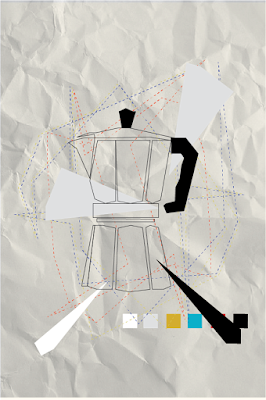Coffee / Dony Plume
Coffee is an essential component of the home. Whether a creature comfort on lazy weekend mornings or an essential fuel driving the direction of the day, coffee consumption is ingrained in the fabric of living.
Coffee beans are seeds grown inside a fruit, much like a cherry. The trees are typically divided into two common species (though there are many uncommon types considered commercially unviable due to low production or poor quality). Robusta is a hearty plant capable of yielding tremendous quantity at the expense of quality. Coffee brewed from Robusta is typically very bitter and very high in caffeine, and is typically sold cheaply and blended. Arabica is a fragile plant with innumerable botanical varieties of varying popularity, generally considered high in quality. Arabica coffee may trade at extreme premiums depending on demand and quality, and frequently offers better sweetness, more acidity, and less bitterness than Robusta.
The trees, scrappy shrubs really, grow only in the band of tropics around the center of the globe, predominantly in Central & South America, East Africa, India, and Indonesian islands. Arabica must have sufficient elevation, typically 1000+ meters above sea level, to thrive. Brazil is the world’s leading producer of coffee, exporting nearly 40% of global supply. In recent years, Vietnam has outpaced Colombia as the next largest producer, though Vietnamese coffee is nearly entirely Robusta and considered a cheap, low quality substitute.
Ethiopia, particularly the western region bordering South Sudan, is considered the homeland of Arabica; the origin of the species. It is among the only places in the world where Arabica coffee grows wild in forests. Ethiopia is the only producing country that consumes more than it exports, and there is an intricate tradition known as the Coffee Ceremony that involves a woman (typically the head of the household or a prominent community figure) roasting, grinding, brewing and serving the commodity for guests.
In its earliest days, coffee was first consumed in berry form (though the berries support little flesh, the skin is thick and flavorless, and the seed large and unpleasant to eat raw). The fruit was originally mashed together with animal fat and consumed much like an energy bar. The origins of the beverage are a mystery to time, but in modern times coffee is produced exclusively as an ingredient for brewing.
Production of coffee takes tremendous time and resources. Most coffee trees will not produce fruit until the 3rd year of growth. Arabica trees in particular need a regimented diet of macro and micronutrients and a strict schedule of drought and rain. After the cherries are picked (usually by hand), they are either sun dried (“Natural Process”) or mechanically stripped of fruit, fermented, and then dried (“Washed Process”). In the early 1990s, Brazil developed a hybrid system referred to in Portuguese as “Cereja Descascado” – literally “peeled cherry.” There are now many variations on this hybrid wet processing referred to variously as “Pulped Natural,” “Honey Process,” and “Semi-Washed.” Regardless of wet processing method, after fully dried, the coffee must be shucked, foreign objects and defects are removed (either by machine or hand), and the beans sorted for size and density.
The Silk Route brought coffee to the rest of the world, and Yemen was among the first places to produce it commercially. Stories exist of Arab traders meticulously stripping each individual (bean of its embryo before selling it to maintain control of the market.
Coffee is typically exported in 60-70kg (132-152 lb) jute bag sacks. The polished, export grade coffee is raw in seed form, and is typically a bluish or grayish green color. The next step in processing involves roasting. Among the more common small-batch specialty roasters are “drum” roasters in which the coffee beans are tumbled in a metal cylinder in an environment of heat, typically gas fired. Coffee goes through numerous chemical changes that include Maillard Reactions and Sugar Browning. Roasting coffee will pop as it traps and then releases moisture. Degree of roast has relatively little to do with brew strength or caffeine content, but darker coffee is less dense and has higher concentrations of carbon and bitterness.
The brewed beverage is a reddish-brown liquid and is a solution of suspended particles, predominantly acids and sugars, extracted from broken fragments of roasted beans (“grounds”) by water. The most common methods of extraction are filtered ‘drip’ coffee, immersion (French press), and pressurized brewing (espresso). Filtering the ground coffee is essential to its enjoyment, as consuming the ground particles is not considered a pleasant experience. Specialty roasters and coffee enthusiasts recommend heating water just under boiling and using a 1-to-16 ratio of coffee to water (except when brewing espresso, when the ratio is closer to 1-to-2).
Caffeine is the most commonly known chemical present in coffee and is widely enjoyed for its legal stimulant effects. Coffee is also high in antioxidants and in recent years studies have shown it to have positive effects on memory retention and slowing the progression of diseases like cancer and Alzheimer’s. While consumption in Ethiopia, the ancient Arab world, and pre-Industrial Europe was frequently a pleasurable and cultural experience, Industrialization repurposed the beverage as a utilitarian one and large-scale production was the norm until relatively recently.
At the moment coffee is undergoing a quality renaissance; small-batch roasters and specialty level producers across the globe are developing new methods and re-envisioning the beverage as a specialty-level craft on par, and in tandem with other upcoming trends the likes of craft beer and farm-to-table dining. Simultaneously, coffee trees are at risk from ongoing threats like fungal infections and new ones like climate change, and farmers increasingly are raising generations of children far more interested in education and high-paying jobs than thankless lifelong labor as an agricultural worker. While we’re not there yet, the global demand for coffee will soon outpace supply.
But if there’s one thing to remember about the incredible story of coffee it’s this: it’ll make you poop.


Comments
Post a Comment